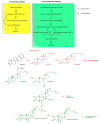Phytoecdysteroids: Distribution, Structural Diversity, Biosynthesis, Activity, and Crosstalk with Phytohormones
- PMID: 35955797
- PMCID: PMC9369314
- DOI: 10.3390/ijms23158664
Phytoecdysteroids: Distribution, Structural Diversity, Biosynthesis, Activity, and Crosstalk with Phytohormones
Abstract
Phytoecdysteroids (PEs) are naturally occurring polyhydroxylated compounds with a structure similar to that of insect molting hormone and the plant hormone brassinosteroids. PEs have a four-ringed skeleton composed of 27, 28, 29, or 30 carbon atoms (derived from plant sterols). The carbon skeleton of ecdysteroid is known as cyclopentanoperhydrophenanthrene and has a β-sidechain on C-17. Plants produce PEs via the mevalonate pathway with the help of the precursor acetyl-CoA. PEs are found in algae, fungi, ferns, gymnosperms, and angiosperms; more than 500 different PEs are found in over 100 terrestrial plants. 20-hydroxyecdysone is the most common PE. PEs exhibit versatile biological roles in plants, invertebrates, and mammals. These compounds contribute to mitigating biotic and abiotic stresses. In plants, PEs play a potent role in enhancing tolerance against insects and nematodes via their allelochemical activity, which increases plant biological and metabolic responses. PEs promote enzymatic and non-enzymatic antioxidant defense systems, which decrease reactive oxygen species in the form of superoxide radicals and hydroxyl radicals and reduce malondialdehyde content. PEs also induce protein biosynthesis and modulate carbohydrate and lipid synthesis. In humans, PEs display biological, pharmacological, and medicinal properties, such as anti-diabetic, antioxidant, anti-microbial, hepatoprotective, hypoglycemic, anti-cancer, anti-inflammatory, antidepressant, and tissue differentiation activity.
Keywords: allelopathy; anti-stress activity; germination; growth regulators; heavy metals; isolation; pathogen; salinity.
Conflict of interest statement
The authors declare no conflict of interest.
Figures






References
-
- Butenandt A., Karlson P. Über die isolierung eines metamorphose-hormons der insekten in kristallisierter form. Z. Naturforsch. B. 1954;9:389–391. doi: 10.1515/znb-1954-0601. - DOI
-
- Dinan L., Harmatha J., Volodin V., Lafont R. Phytoecdysteroids: Diversity, biosynthesis and distribution. In: Smagghe G., editor. Ecdysone: Structures and Functions. Springer; Dordrecht, The Netherland: 2009. pp. 3–45. - DOI
-
- Hikino H., Takemoto T. Ecdysones of plant origin. In: Burdette W.J., editor. Invertebrate Endocrinology and Hormonal Heterophylly. Springer; Berlin/Heidelberg, Germany: 1974. pp. 185–203. - DOI
Publication types
MeSH terms
Substances
LinkOut - more resources
Full Text Sources

